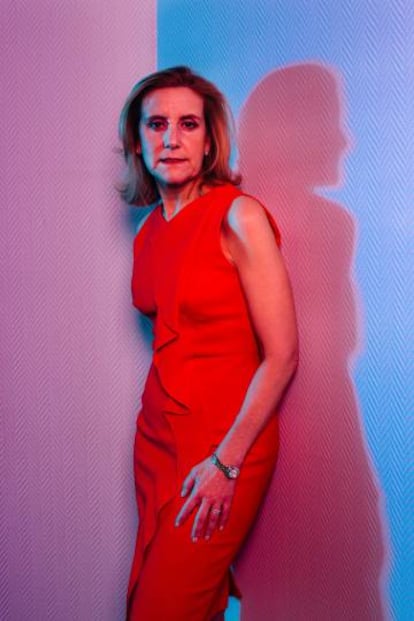Why the next tech revolution will be a female affair
In Spain, companies such as Google, Facebook, LinkedIn, Siemens, IBM and Microsoft are all run by women. This is no coincidence. There is a drive from the top to attract female talent to an industry routinely dominated by men. Because, besides being ethical, it makes economic sense. Nowadays, it is commonly held that only companies with a diverse workforce will survive. And so the women in this feature are working to reverse the longstanding trend for girls to turn their back on careers involving technology and engineering. It is a huge challenge, but one they have gladly taken on
Rosa García was 36 when she returned from the US to become president and CEO of Microsoft Ibérica. “I felt a tremendous responsibility,” she says. “We pioneers had to do a good job for two reasons: to encourage other women to believe they could make it to the top, and to make directors see that putting a woman in charge was good business.”
Since then, Microsoft Ibérica has taken on one female president after another. Rosa García was followed by María Garaña and then Pilar López who is now at the helm, managing a team of 700.
But the winds of change are not just blowing through Microsoft. The same thing is happening at Google, which has Fuencisla Clemares running the show, Facebook with Irene Cano, LinkedIn with Sarah Harmon, Siemens with Rosa García and IBM with Marta Martínez. Clearly, when women are offered the same opportunities as men, they know how to run with them.

“Technology doesn’t have a history of ‘It’s always been done this way’ to contend with,” says Mireia Las Heras, Professor of Human Resources at the IE Business School in Madrid. “It is a more flexible industry and it’s been savvy about making the most of both male and female talent. In the more traditional [engineering] sectors, the atmosphere is more favorable to men. It’s not intentionally exclusive, it’s just that men have always occupied the jobs and so structures and procedures have been created to suit them.”
In 2014, Google published data on the diversity of its workforce, deciding on a transparent approach to the issue. The report showed there were 70% men and 30% women employed by the tech giant. And of the women, only 21% were in senior positions and just 17% had tech jobs. Subsequently, LinkedIn, Yahoo, Twitter, Pinterest, eBay, Apple and Microsoft also published detailed statistics on staff composition, revealing that there was still a long way to go. But at least here was an industry that looked prepared to face the problem head on.
According to a recent LinkedIn study, between 2006 and 2016 the number of women in positions of responsibility rose 18% in the tech industry globally. There has also been a rise in women filling tech-based vacancies in general; since 2006, there has been a 67% increase in female designers, 60% in female directors and 43% in female web developers.

The US boss of LinkedIn in Spain and Portugal, Sara Harmon, believes that we are making gradual progress. “I do think tech companies have understood the importance of inclusion,” she says. “At LinkedIn, we try to be diverse because we want to be competitive. The approach the tech industry has adopted doesn’t seem to have filtered down to other sectors. Everybody knows it’s right, but a lot of companies have still not realized that it’s actually good for business.”
The women in this report all agree diversity gives companies a competitive edge. “When you have access to different points of view, any debate becomes infinitely broader and better decisions are reached,” says Fuencisla Clemares, Country Manager at Google Spain and Portugal. “Our products are aimed at everyone, so our staff need to mirror society to enable us to come up with developments that will be useful for everyone – irrespective of their gender, race, religion, culture or sexual orientation.”
It’s important to see women at the head of technology companies. We need role models. We can’t always be falling back on Marie Curie!
Last year, Google announced that the number of women working for them had crept up by one percentage point to 31% from 2014. In Facebook, there was also a one-point increase – from 32% to 33%. In Microsoft, however, the number of women working went into reverse. In 2015, 31,064 of its employees were women but this dropped to 29,302 in 2016. In an industry used to constant and often vertiginous progress, change in this sphere is proving an uphill struggle, resulting in criticism from women’s associations and the media.
“In the last eight years, I’ve worked in an office with more women than men and I’ve always tried to make sure my teams are diverse,” says Irene Cano, Country Manager Iberia at Facebook Iberia. “But although the women who have reached the top in the tech sector are very visible, we shouldn’t get the wrong impression: in Spain, girls don’t want to study STEM degrees [science, technology, engineering and mathematics]. And only 4% of CEOs in tech companies are women. I would be lying if I said I wasn’t operating in a masculine environment. In most meetings I go to, I am still the only woman – at best there is one more at the other end of the room. Obviously, this does not do much to foster equality or make it easy to express oneself. The fact you’re in a minority makes you feel your position is weaker when it comes to giving your opinion and taking decisions. But I haven’t felt it’s got in the way of my career development. As you can see, here I am. But I have had to put up with a lot of things I don’t think my male colleagues have had to go through.”
All six women say their position within their respective companies has at times been met with surprise and curiosity. “Obviously, we are different and sometimes, depending on the culture and atmosphere, it’s harder for people to understand and appreciate your style,” says Clemares. “For example, when I worked in consulting I was told I wasn’t being assertive enough and my message wasn’t getting across. This surprised me because I had a great relationship with my clients but I sought help and was told: ‘Talk louder.’ As it was a male-dominated environment and I was different, they didn’t know how to deal with it. Did that mean I had to work harder? No. I developed my own style which was also effective and got results.”
At the start of this month, the Royal Academy of Engineering (RAL) wound up its first mentoring program, run by the Women in Engineering Project, and which aims to address sexual inequality in the sector.
“Engineering is still a hostile environment for women,” said one of the female mentors working in the renewable-energy sector at the project’s conference in the Marqués de Villafranca Palace in Madrid. “We miss you! We are very happy being surrounded by men but we have to reverse the trend and realize that we at least have a different vision to offer.”
This view contrasted with the optimism of one of the male academics, who had declared at the start of the conference that a balance had all but been achieved, eliciting a murmur of protest and a shaking of heads from the predominantly female audience. No, no, no. The battle from where they were sitting was clearly a long way from over.
In Spain, 54% of degree students are women. Most study nursery education, nursing, psychology, medicine, primary education or law. In the academic year 2015-2016, women accounted for 12.1% of technological engineering students and 13% of mechanical engineering students. Only two of the female executives in this report studied science at university.
Women still find it hard to imagine themselves as engineers and mathematicians. Families and schools should think about how they are educating their girls
“It’s a general problem,” says Sara Gómez, who heads the RAL project and is the first woman to direct the University School of Technical and Industrial Engineering at the Madrid Polytechnic. “There are fewer girls and boys wanting to study engineering. There is a notable drop in applications. But in the case of girls, it’s more serious. Girls still find it hard to picture themselves as engineers or mathematicians. A gender balance only exists in architecture and biomedicine. Families and schools should think about how they are educating the girls. They have to impress upon them that the only thing limiting them are their abilities, not their gender.”
According to a study carried out by the L’Oreal Foundation in 2015, 63% of Spaniards think that, from the moment they’re born, girls are treated like princesses who will never have the ability to access executive jobs in a scientific sphere.

In 2016, the global gap between the numbers of men and women studying to enter STEM careers reached 47%, according to the World Economic Forum. The imbalance is often attributed to a combination of negative stereotypes and an absence of female role models that help boost self-esteem and nurture the aspirations of girls with an aptitude in this field.
“In IBM we run a program in collaboration with the most important universities in the country,” says Marta Martínez, General Manager for Spain, Portugal, Greece and Israel at IBM. “We try to indicate where most of the technical jobs will be while debunking the myth that these jobs are hard. It’s one of the most important things we do, but we’ve been realizing for a while now that the intervention has to come earlier.”
A recent Microsoft study showed that 11-year-old girls share the same interest in science and technology as boys. However, by the time girls reach 15, their interest has diminished. “When we visit schools, we find there’s an enormous lack of confidence,” says Pilar López, Country General Manager at Microsoft Spain. “The girls say, ‘Those jobs are not for me, I wouldn’t be able to do them. They’re only for clever people.’ And this comes from girls with enormous potential.”
Technology companies have grasped the importance of being inclusive because they want to be competitive. It’s not just right, it’s also good for business
When Sara Gómez goes into classrooms to explain what engineering consists of, she gets strange looks and is sometimes asked if engineering isn’t just for boys.
“When we speak to the kids we still see behavior more appropriate to the era I studied in than to this one,” says Gómez, who took her industrial engineering degree at the end of the 1970s when it was commonly believed that girls signing up for the course were only doing so so that they could marry an engineer. “But some of the girls come to me afterwards to ask for more details because they don’t dare do so in front of their male classmates. They are scared they will be considered odd.”
Engineering student Jessica Amo says that, although women are still in the minority in class, the atmosphere at university is positive, though the stereotypes persist. “You still hear people saying things like, ‘What are you doing here? Go home and wash up’,” she says. “And there are lecturers who warn us that we will have to develop our personalities so we can wield authority when it comes to work projects.”

One role model who is being resurrected is Ada Lovelace, daughter of the British poet Lord Byron. She is considered not just the first female computer programmer but the first computer programmer in history, ahead of her male colleagues when she published a program in 1843 for a computer prototype designed but never made for the mathematician Charles Babbage.
Now her genius is being celebrated every year on October 15, a decision taken in 2009 as a means of inspiring future generations of women.
“Not even computer students have heard of her,” says Montse Cervera, an industrial engineering student at Carlos III University, Madrid. “But this is great because we hardly have role models. We can’t keep falling back on Marie Curie! That’s why it’s important to see women at the head of technology companies. It makes it look as though it’s easier to get there.”
More current inspiration will come from the likes of Pilar López, and the other five female executives. “I am very conscious of the fact that we need to act as role models,” says López. “Attracting female talent is a fundamental part of my job. That would also be the case if I were a man, but I have my experience and conviction to offer.”
English version by Heather Galloway.


